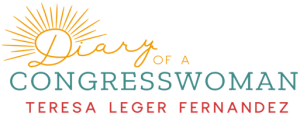Teresa Leger Fernandez:
Let’s go quickly because we have been nonstop all day and I’m exhausted.
Mary-Charlotte Domandi:
Yeah, it was your first time today that you spoke on the floor of the house.
TLF:
I spoke on the floor of her house for the first time, and I spoke twice. So my first comment was more broad. It was about basically the theme of what we want to do. And I really think that I want to be about creating opportunity in places of poverty, creating an opportunity, all over the place. That really we are kind of the party of opportunity. That’s what we’re supposed to be about, is protecting what we love. But then when you protect what you love, you then want to help make it thrive, and in order to make it thrive you have to create opportunities, especially when there are obstacles in front of it.
So the idea of the first speech was to sort of set out a theme of what I want to be and what my district is like, and you have a minute to do it. So you have to be very efficient. And then like, then what does that mean? And what that means in this instance is the Learning Recovery Act, because education is really the key to realizing the promise. I often said during the campaign, and now I said on the floor of the house, to understand my district you need to know not only its beauty, but also its poverty and its promise. And then the theme of opportunity and education really is the key to unlocking the promise, to realizing the promise. And I talked about the Learning Recovery Act, because that’s what we need to do to make sure we don’t make the education gap any further.
So that was wonderful. But then it was really great to participate and the debate about the reconciliation bill and why do we need to do this now? So my second comments on the floor to my colleagues was about why we need to do it now. And it really was, we cannot wait, like we’ve been waiting too long, like our job, that’s what I said, our job is to fix problems. Right, and if we don’t fix problems why are we here? And so we need to act now. And it really felt good. And the other cool thing about the first one, because the first one I have to be in under one minute and the second one, you know, we had some notes and then they gave me more time. And so I got to really ad lib and talk about and respond to what they were saying and talk back about, listen, I’m listening to the people, whether they’re rural, suburban, Latino Hispano, Native American, like we’re listening to them and they want us to act.
And so it was, that was also a lot of fun. And then we had just, you know, one vote, one vote, one vote. And then you have to figure out all of the like, okay, this is the vote to call the question. But then we have these two amendments and these ones we vote no on. And this one, you know, so you have to make sure you keep track so you don’t vote wrong. Right. There was a woman. Yeah. There was a woman, you know, there was an, uh, a Democratic colleague who went, I need to go back in there cause I need to change my vote. I voted wrong! So she ran into a change her vote from yes to no. So it was fun.
MCD:
Do you think speeches like that—sometimes I watch C-SPAN and see people giving their speeches and sometimes their speech is to an empty chamber, and sometimes everybody’s listening. Do people listen? Is it an exercise in saying what you need to say? Or is there a real sense of a dialogue and participatory people listening to each other?
TLF:
I think that there is a dialogue often on the debates on the bills and stuff like we were responding—a Republican would get up and say something and then we would respond to that, or they’d respond to it. Like the first one minute was really, I am saying what I’m here for. So that wasn’t a debate. And the debate side, they were like, Oh, we don’t want that. People don’t want this. You know, our rural America doesn’t—it’s like you’re making rural—I responded to what they were saying and therefore felt like it was a dialogue with their argument. And I think, there might’ve been an empty room, but I had a lot of people come up to me because we might have more of an empty room, but people are listening to it on their C-SPAN in their offices or they’re listening to it, and it’s helping us all think about how do we go back and talk to our communities about this. And I told Steny Hoyer, the majority floor leader, listen, all of those things that were said with regards to the Marjorie Taylor Greene, the Republicans have told us who they are. They are a group that is refusing to take action against somebody who espouses these violent conspiracy theories, just horrible things, these racist anti-Muslim, I could go on and on, antisemitic things.
MCD:
I’m still caught up in Jewish space lasers.
TLF:
Yeah, the Jewish space lasers, and Muslims don’t belong in the House. And here’s a picture of me with my gun. So I think what we’re also doing is we are talking to our constituencies. We have to remember, it’s not just us. We represent people. And so my speech is going to be heard by some of my constituents. And that’s what’s important. So they can go back and say, what is Teresa saying? And I said, New Mexicans are this and New Mexicans are that, and my district is this. And so they can see that I am taking their viewpoints onto the floor of the house. And that’s, what’s important. So when people say, Oh, it’s an empty room, well, I’m not just talking to the Republicans or the Democrats. I’m talking to my constituents and I’m talking to the future. We’re setting a record.
MCD:
On that note. I will let you go. Thank you so much.


